Bio security on your dairy farm
BIOSECURITY FOR DAIRY FARMS
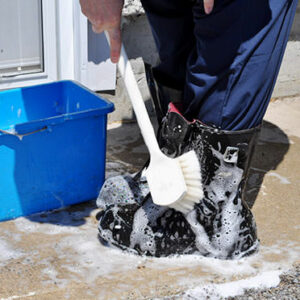 Biosecurity is becoming increasingly important to the dairy sector, which continues to evolve toward fewer, larger farms with high-producing milking animals. This sector provides consumers with wholesome milk and dairy products, and is also the source of valuable genetics for the international marketing of semen and embryos. semen and embryos can be moved internationally under strict sanitary regulations and controls put in by trading partners. The risk of transfer of disease is costly, requires isolation and qualified AI centre stationed donor animals.
Biosecurity is becoming increasingly important to the dairy sector, which continues to evolve toward fewer, larger farms with high-producing milking animals. This sector provides consumers with wholesome milk and dairy products, and is also the source of valuable genetics for the international marketing of semen and embryos. semen and embryos can be moved internationally under strict sanitary regulations and controls put in by trading partners. The risk of transfer of disease is costly, requires isolation and qualified AI centre stationed donor animals.
On your farm , why should this great care stop? At a very reasonable cost to the farmer, cots of disease incursion and potential production loss can be avoided. When using proven Fleckvieh sires in particular, this genetic material grows into great animals. The basis for a good dairy – dual purpose genetics is there. The two hurdles of environmental exposure and/or poor management practices can throw this benefit to the wolves. Let`s not do that!
Bovine diseases – Why biosecurity?
The global emergence and re-emergence of bovine diseases in recent years has had a major impact on the cattle industry, both within Canada and abroad. Outbreaks of contagious diseases such as Foot and Mouth Disease in cattle in other countries have resulted in significant economic losses for cattle industries, as well as animal health and environmental concerns. These kinds of incidents emphasize the need for a comprehensive, coordinated approach to bovine biosecurity.
Disease in milking dairy cattle and other bovine animals can be spread in a number of ways, including:
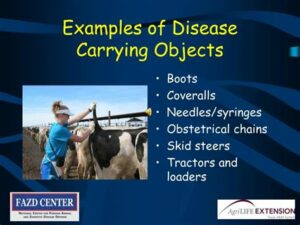
•through diseased cattle or healthy cattle incubating disease;
•through animals other than cattle (farm animals, pets, wild birds and other wildlife, vermin and insects);
•on the clothing and shoes of visitors and employees moving from farm-to-farm;
•in contaminated feed, water, bedding and soil;
•from the carcasses of dead animals;
•on contaminated farm equipment and vehicles as well as Veterinary supplies, dirty needles for example;
•in airborne particles and dust blown by the wind.
Biosecurity principles for dairy herds
Some of the basic biosecurity principles for the dairy sector include:
•Isolation:
◦Only obtain new animals from reputable sources.
◦Isolate sick animals from the rest of the herd.
◦Limit the frequency of introducing new animals to the herd.
◦Isolate any new animals or animals returning to the herd.
◦Separate cattle by age or production groups.
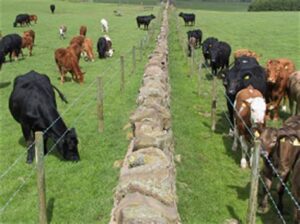
•Sanitation:
◦Routinely clean and disinfect buildings, barns, equipment, clothing and footwear.
◦Designate a cleaning area for vehicles and equipment.
◦Promptly dispose of dead animals.
◦Implement a manure management program.
◦Avoid borrowing equipment and vehicles from other farms.
•Traffic control:
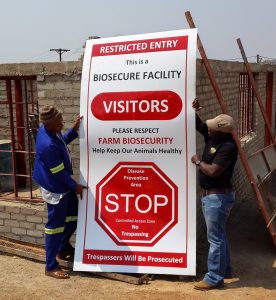
◦Control visitors’ access to the herd.
◦Prevent birds, rodents, pets and other animals from coming into contact with the herd.
◦Require all visitors to wear clean boots, clothing and gloves. An even better practice is to provide coveralls and boots to all visitors.
◦Maintain records of the movement of people, animals and equipment on and off the premises.
◦Make sure all suppliers and other farm visitors follow your biosecurity measures.
•Herd health management:
◦Monitor herd health daily.
◦Identify all animals with proper ear tags for traceability.
◦Employ veterinary services to help implement herd health programs along with culling or salvage programs.
◦Vaccinate cattle against certain diseases.
◦Immediately report any signs of illness to your veterinarian or the nearest CFIA office.
•Program maintenance:
◦Train all staff in the application of your biosecurity program.
◦Regularly monitor the effectiveness of the program.
◦Be aware of any diseases in your area and adjust your biosecurity program to meet specific needs, as required.
What are some things to think about as a take home message from this article?
1. Keeping a closed herd is a great concept but not always attainable. What are some risk factors?
• Cattle are purchased or boarded;
• Cattle return to the herd after going to shows, community pastures or performance evaluation centers;
• Cattle use a pasture that shares a fence line with cattle in pasture on a different farm;
• Bulls are purchased, borrowed or loaned; and
• Cattle from the herd are transported by someone else or in someone else’s vehicle
2. Purchasing new cattle – this you may need to do if your own replacement rate is not enough or you want to expand you dairy farm
It is important to plan the introduction of animals to minimize the risk that an infectious disease will be brought in at the same time. Three factors are important in reducing the risk of infectious diseases when purchasing new cattle.
• The protection you have given your herd by proper vaccination
• The source of purchased cattle, including how they are transported to the farm
• The method you will use to actually introduce the new cattle to the rest of the herd
3. Resident cattle
Make certain your own cattle are properly vaccinated according to the manufacturer’s and your herd veterinarian’s recommendations before bringing new cattle into the herd.
4. The source of purchased cattle
• Bring in only animals from herds where you know the health status.
• Bring in only animals from herds with a known effective vaccination program. Get specific information about the vaccination history such as when vaccine was used and when it was given. If killed vaccines were used, make sure that a primary series (two doses given a few weeks apart) was given.
• Avoid purchasing animals from unknown sources or that have been mixed with other cattle
• Buy heifers when purchasing a group of cattle. Because they aren’t milking, heifers are easier to quarantine.
• Ask for health information about purchased cattle. Ask for the DHIA somatic cell count information on milking cows. Test the bulk tank for contagious mastitis.
• Transport animals in a vehicle that has been cleaned and disinfected before pick up.
5. Introducing new arrivals
• Quarantine new animals for 30 days before allowing contact with animals on-farm.
• Designate your quarantine area. It should be separated from other cattle on your farm. To prevent the spread of respiratory diseases, quarantined cattle should not share the same airspace with resident cattle.
• Quarantined cattle should not share feeders, waterers or equipment with resident cattle.
• Use a medicated foot bath before allowing purchased cattle to enter the herd.
• Prevent the spread of contagious mastitis by milking the new animals last. Sanitize the milking equipment after milking new cattle.
• Check the new animal’s temperature every day or at least every other day during the quarantine period. If it develops a fever, have it checked out by your veterinarian.
• Vaccinate cattle while they are in quarantine.
6. Test all purchased cattle for infection with
• BVD virus
• Johne’s disease
• Bovine leukosis (optional)
It can take 1 -2 weeks to get test results so collect and submit the samples as soon as the animal arrives.
7. Controlling farm traffic
Infectious diseases can be carried by people and equipment too. If you borrow equipment from other farms, make sure it has been cleaned before using it on your farm. Producers should limit access on the farm to calves and fresh cows since they are most susceptible to infectious disease.
Some steps to reduce the risk of introducing infectious diseases:
• Limit people’s access to the barn. This may mean locking the door to the barn.
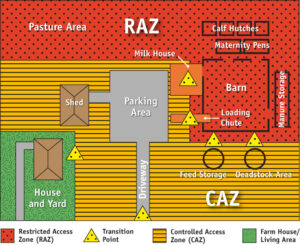
• Post a warning sign asking visitors to keep out. It helps to provide information on who to contact or a telephone number to call instead of entering the barn. If you establish areas that are like on the picture shown, you can step up your bio security. Prevention is a lot more effective and cheaper than running into a problem.
• Make sure visitors wear clean boots and clothing in the barn. This is important if visitors have already been in other barns. Provide some large size coveralls and boots in the barn for visitors to wear. Disposable plastic boots can be used but they wear out quickly.
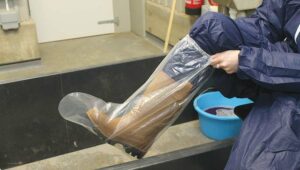
• Have bull calves and other sale animals picked up without allowing the dealer or transporter to enter the barn.
• Have dead animals picked up without allowing the livestock renderer to enter your barn or come in contact with your animals.
• Keep a record of visitors.
• Use your own halters and ropes.
It is difficult to control all traffic on the farm but you can identify the traffic that represents the most risk. These include people who frequently visit other farms and people who have already visited other farms on the day they visit your farm.